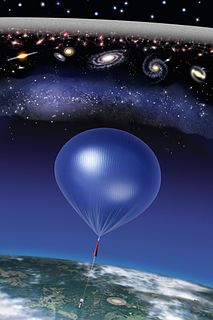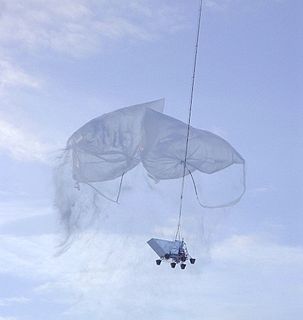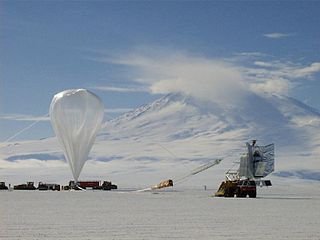 W
WA balloon-borne telescope is a type of airborne telescope, a sub-orbital astronomical telescope that is suspended below one or more stratospheric balloons, allowing it to be lifted above the lower, dense part of the Earth's atmosphere. This has the advantage of improving the resolution limit of the telescope at a much lower cost than for a space telescope. It also allows observation of frequency bands that are blocked by the atmosphere.
 W
WAbsolute Radiometer for Cosmology, Astrophysics, and Diffuse Emission (ARCADE) is a program which utilizes high-altitude balloon instrument package intended to measure the heating of the universe by the first stars and galaxies after the big bang and search for the signal of relic decay or annihilation. In July 2006 a strong residual radio source was found using the radiometer, approximately six times what is predicted by theory. This phenomenon is known as "space roar" and remains an unsolved problem in astrophysics.
 W
WArcheops was a balloon-borne instrument dedicated to measuring the Cosmic microwave background (CMB) temperature anisotropies. The study of this radiation is essential to obtain precise information on the evolution of the Universe: density, Hubble constant, age of the Universe, etc. To achieve this goal, measurements were done with devices cooled down at 100mK temperature placed at the focus of a warm telescope. To avoid atmospheric disturbance the whole apparatus is placed on a gondola below a helium balloon that reaches 40 km altitude.
 W
WThe Balloon-borne Large Aperture Submillimeter Telescope (BLAST) is a submillimeter telescope that hangs from a high-altitude balloon. It has a 2-meter primary mirror that directs light into bolometer arrays operating at 250, 350, and 500 µm. These arrays were developed for the SPIRE instrument on the Herschel Space Observatory. The project is carried out by a multi-university consortium headed by the University of Pennsylvania and which also includes University of Toronto, Brown University, the University of Miami, the University of British Columbia, JPL, INAOE, and Cardiff University. The third flight of BLAST in Antarctica was a scientific success, but much of telescope was destroyed after landing. It has been rebuilt for a flight from Antarctica in the 2010-11 austral summer. This most recent flight of BLAST has a polarimeter to observe the polarized light from star forming cores. The light is polarized due to magnetic fields. It is thought that the magnetic fields inhibit the collapse of the cores. The Herschel Space Observatory does not have a polarimeter.
 W
WIn astronomy and observational cosmology, the BOOMERanG experiment was an experiment which measured the cosmic microwave background radiation of a part of the sky during three sub-orbital (high-altitude) balloon flights. It was the first experiment to make large, high-fidelity images of the CMB temperature anisotropies, and is best known for the discovery in 2000 that the geometry of the universe is close to flat, with similar results from the competing MAXIMA experiment.
 W
WThe Balloon Rapid Response for ISON (BRRISON) was a NASA project involving a stratospheric balloon with science instruments intended to study comet C/2012 S1 (ISON) and other celestial objects.
 W
WThe Gamma-Ray Imaging Spectrometer (GRIS) was a gamma-ray spectrometer instrument on a balloon-borne airborne observatory. It used germanium detectors to achieve high resolution spectroscopy. GRIS was operated from 1988 to 1995 by NASA's Goddard Space Flight Center, which called it "arguably one of the most successful gamma-ray balloon programs in history".
 W
WHigh-Energy Replicated Optics (HERO) is a high-altitude balloon-borne x-ray telescope based at the Marshall Space Flight Center. Its mirrors are conical approximations to Wolter type 1 geometry. The proving flight, at least, used a high-pressure gas scintillation proportional counter with relatively low spatial resolution.
 W
WThe Stratoscopes were two balloon-borne astronomical telescopes which flew from the 1950s to the 1970s and observed in the optical and infrared regions of the spectrum. Both were controlled remotely from the ground.